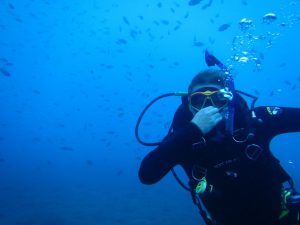
Have you ever wanted to dive below the surface of the water? If so, it’s important to learn more about equalizing. As you descend, pressure builds up in the inner and outer parts of your ears, which at a few feet can be uncomfortable, but a bit deeper, can lead to major ear damage. Equalizing balances out that pressure, and opens something called the Eustachian tubes, which connect to the empty air space of the middle ear. Throughout our daily lives, we are often equalizing the pressure in our ears by simply swallowing or yawning. When we dive underwater however, we often need a more deliberate method to make sure that the pressure becomes equalized.
 One of the most common techniques for equalizing underwater is something called the Valsalva maneuver. For this method, you simply pinch your nose, keep your mouth closed, and blow out. The high amount of pressure in your throat then prompts the Eustachian tubes to open and equalize the pressure in your ears. This method is one of the first that is generally taught to new divers, but it is important to understand that there are still risks. Making sure not to blow too hard can help to prevent damage to the round and oval windows in the inner ear. Other common equalizing techniques include the Toynbee Method, the Lowry Technique, and Voluntary Tubal Opening, among others. For the Toynbee Method, the nose is pinched, and the diver swallows to open the Eustachian tubes. The Lowry Technique combines both the Valsalva and Toynbee methods by pinching the nose and then blowing out and swallowing at the same time. As divers practice equalizing, they may become more comfortable with a specific technique, or learn to control their muscles especially well. For Voluntary Tubal Opening, a diver may learn how to continuously equalize the pressure in their ears by tensing their throat and jutting their lower jaw forward and down similar to a yawn.
One of the most common techniques for equalizing underwater is something called the Valsalva maneuver. For this method, you simply pinch your nose, keep your mouth closed, and blow out. The high amount of pressure in your throat then prompts the Eustachian tubes to open and equalize the pressure in your ears. This method is one of the first that is generally taught to new divers, but it is important to understand that there are still risks. Making sure not to blow too hard can help to prevent damage to the round and oval windows in the inner ear. Other common equalizing techniques include the Toynbee Method, the Lowry Technique, and Voluntary Tubal Opening, among others. For the Toynbee Method, the nose is pinched, and the diver swallows to open the Eustachian tubes. The Lowry Technique combines both the Valsalva and Toynbee methods by pinching the nose and then blowing out and swallowing at the same time. As divers practice equalizing, they may become more comfortable with a specific technique, or learn to control their muscles especially well. For Voluntary Tubal Opening, a diver may learn how to continuously equalize the pressure in their ears by tensing their throat and jutting their lower jaw forward and down similar to a yawn.
So when do you equalize? The most important things to remember are to equalize early and to equalize often. If you have a dive planned for later in the day, it is a good idea to start equalizing a few hours beforehand every few minutes. Before going underwater, always equalize on the surface. Then, as you descend, make an effort to equalize about every two feet to avoid the tearing of tissue or eardrum damage. If at any point your ears hurt, make sure you don’t push through the pain and continue to descend. Equalization takes practice, but diving underwater can take you to a whole new world in the ocean!
Written by: Jaclyn Lucas


